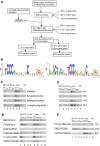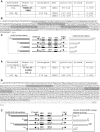Genome-wide evidence for an essential role of the human Staf/ZNF143 transcription factor in bidirectional transcription
- PMID: 21177654
- PMCID: PMC3082894
- DOI: 10.1093/nar/gkq1301
Genome-wide evidence for an essential role of the human Staf/ZNF143 transcription factor in bidirectional transcription
Abstract
In the human genome, ∼ 10% of the genes are arranged head to head so that their transcription start sites reside within <1 kbp on opposite strands. In this configuration, a bidirectional promoter generally drives expression of the two genes. How bidirectional expression is performed from these particular promoters constitutes a puzzling question. Here, by a combination of in silico and biochemical approaches, we demonstrate that hStaf/ZNF143 is involved in controlling expression from a subset of divergent gene pairs. The binding sites for hStaf/ZNF143 (SBS) are overrepresented in bidirectional versus unidirectional promoters. Chromatin immunoprecipitation assays with a significant set of bidirectional promoters containing putative SBS revealed that 93% of them are associated with hStaf/ZNF143. Expression of dual reporter genes directed by bidirectional promoters are dependent on the SBS integrity and requires hStaf/ZNF143. Furthermore, in some cases, functional SBS are located in bidirectional promoters of gene pairs encoding a noncoding RNA and a protein gene. Remarkably, hStaf/ZNF143 per se exhibits an inherently bidirectional transcription activity, and together our data provide the demonstration that hStaf/ZNF143 is indeed a transcription factor controlling the expression of divergent protein-protein and protein-non-coding RNA gene pairs.
Figures





Similar articles
-
A genome scale location analysis of human Staf/ZNF143-binding sites suggests a widespread role for human Staf/ZNF143 in mammalian promoters.J Biol Chem. 2006 Dec 29;281(52):39953-62. doi: 10.1074/jbc.M608507200. Epub 2006 Nov 7. J Biol Chem. 2006. PMID: 17092945
-
Transcription of the human cell cycle regulated BUB1B gene requires hStaf/ZNF143.Nucleic Acids Res. 2007;35(10):3453-64. doi: 10.1093/nar/gkm239. Epub 2007 May 3. Nucleic Acids Res. 2007. PMID: 17478512 Free PMC article.
-
Transcription factor hStaf/ZNF143 is required for expression of the human TFAM gene.Gene. 2007 Oct 15;401(1-2):145-53. doi: 10.1016/j.gene.2007.07.011. Epub 2007 Jul 21. Gene. 2007. PMID: 17707600
-
The ubiquitous transcriptional protein ZNF143 activates a diversity of genes while assisting to organize chromatin structure.Gene. 2021 Feb 15;769:145205. doi: 10.1016/j.gene.2020.145205. Epub 2020 Oct 5. Gene. 2021. PMID: 33031894 Review.
-
Bidirectional promoters in the transcription of mammalian genomes.Biochemistry (Mosc). 2013 Apr;78(4):335-41. doi: 10.1134/S0006297913040020. Biochemistry (Mosc). 2013. PMID: 23590436 Review.
Cited by
-
Modulation of gene expression via overlapping binding sites exerted by ZNF143, Notch1 and THAP11.Nucleic Acids Res. 2013 Apr;41(7):4000-14. doi: 10.1093/nar/gkt088. Epub 2013 Feb 13. Nucleic Acids Res. 2013. PMID: 23408857 Free PMC article.
-
Emerging roles of non-coding RNAs in brain evolution, development, plasticity and disease.Nat Rev Neurosci. 2012 Jul 20;13(8):528-41. doi: 10.1038/nrn3234. Nat Rev Neurosci. 2012. PMID: 22814587 Free PMC article. Review.
-
Genomic Determinants of THAP11/ZNF143/HCFC1 Complex Recruitment to Chromatin.Mol Cell Biol. 2015 Dec;35(24):4135-46. doi: 10.1128/MCB.00477-15. Epub 2015 Sep 28. Mol Cell Biol. 2015. PMID: 26416877 Free PMC article.
-
HCFC1 is a common component of active human CpG-island promoters and coincides with ZNF143, THAP11, YY1, and GABP transcription factor occupancy.Genome Res. 2013 Jun;23(6):907-16. doi: 10.1101/gr.150078.112. Epub 2013 Mar 28. Genome Res. 2013. PMID: 23539139 Free PMC article.
-
Kynurenine 3-Monooxygenase Gene Associated With Nicotine Initiation and Addiction: Analysis of Novel Regulatory Features at 5' and 3'-Regions.Front Genet. 2018 Jun 13;9:198. doi: 10.3389/fgene.2018.00198. eCollection 2018. Front Genet. 2018. PMID: 29951083 Free PMC article.
References
-
- Adachi N, Lieber MR. Bidirectional gene organization: a common architectural feature of the human genome. Cell. 2002;109:807–809. - PubMed
-
- Koyanagi KO, Hagiwara M, Itoh T, Gojobori T, Imanishi T. Comparative genomics of bidirectional gene pairs and its implications for the evolution of a transcriptional regulation system. Gene. 2005;353:169–176. - PubMed
Publication types
MeSH terms
Substances
LinkOut - more resources
Full Text Sources

